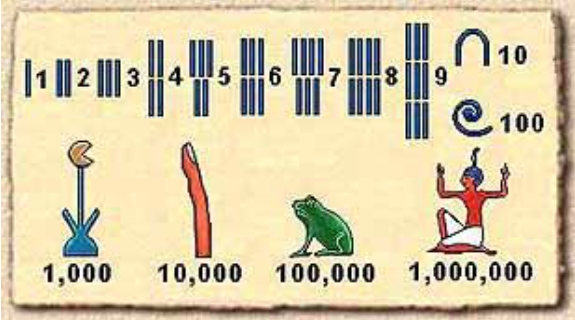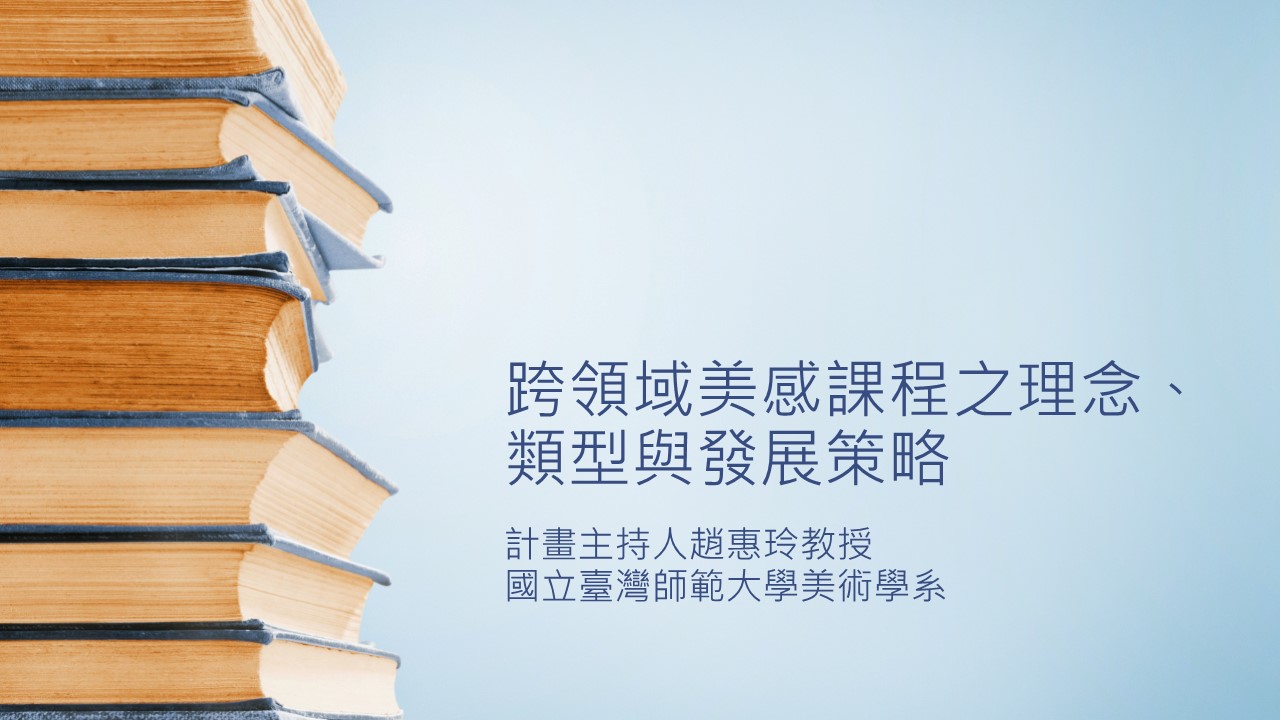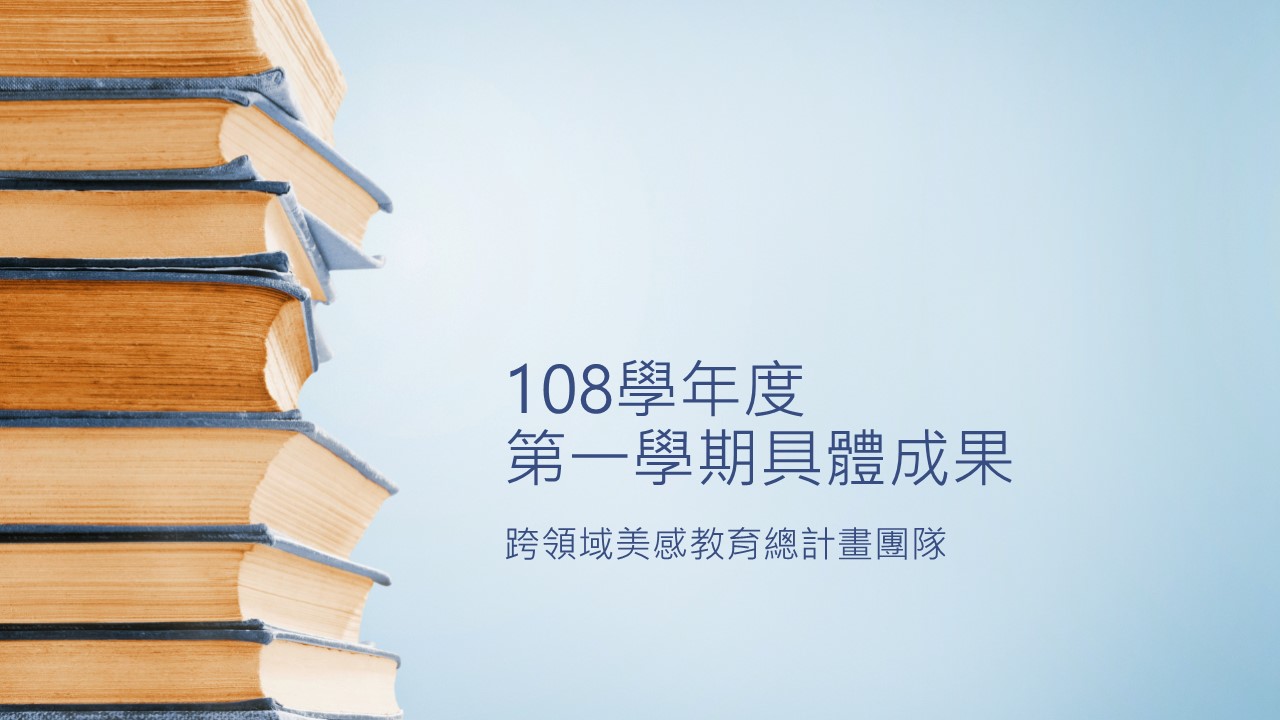Talking about cross-field aesthetic education courses from non-art subjects: Mathematics
Associate Professor Lai Yiwei, Department of Electrical Engineering, National Taiwan Normal University
I. Introduction
When promoting mathematics science, we often quote the famous saying of the ancient Greek mathematician Pythagoras, "Everything is number." Galileo also once said that nature is a book written in mathematics. Mathematics is a language. Since it is a language, it can describe everything. Since it can describe everything, it is naturally everywhere. However, what’s interesting is that when we are promoting mathematics and trying to find ways to make mathematics interesting, we look around for different topics: technology, history, nature... After searching, we suddenly found that the most suitable field for mathematics is the field of art. . In other words, even if it is the combination of mathematics and technology, or the combination of mathematics and nature, no matter how our cross-domain courses are designed, mathematical elements will be deliberately included, and even if not deliberately, they will often be combined with art in the end. Speaking for myself, I also got to know more about art indirectly because of mathematics, and learned a lot from teachers in many art fields.
In this article, we will first cite several cross-domain courses developed by our team at the Number Sense Laboratory, a new education company in Taiwan Normal University. Through several examples, we will share the cross-domain aesthetic education courses we designed from the perspective of mathematics. Secondly, we will introduce how such cross-domain aesthetic courses in mathematics can help mathematics learning. Next, we will introduce another set of course models. Group: pan flute; the end is the conclusion.
2. Cross-domain aesthetic education courses in mathematics
The Number Sense Lab is committed to making mathematics "easy to use, fun, and easy to learn." In order to achieve this goal, our team has tried a variety of promotion methods, operating Facebook fan pages, filming YouTube videos, and even planned a mobile mathematics exhibition "Around the World" in 2021. In response to the global shutdown due to the covid-19 epidemic, we chose Egypt, France, the Netherlands and other countries as themes to look at these countries through the eyes of mathematics. For example, when the plane lands in Egypt (we use travel as the theme of the entire exhibition), we will see the Egyptian slates, and then we will discuss with our classmates the Egyptian hieroglyphs on the slates, which actually represent 1, 10, and 100. and other symbols for various decimal digits.
When we came to France, we walked to Notre Dame de Paris. The classic rose window on the church is the crystallization of the mathematical art of geometry and symmetry. Through the camera of the interactive machine, the system will capture the color of the students' clothes and match the gesture selection to create its own rose window. When we arrived in the Netherlands, we were introduced to Escher, a master of trompe l'oeil art. Although he had no training in mathematics, he had read many papers and books by mathematicians due to the influence of his family, including "The Art of Trompe l'oeil" by Mathematics Educationist Polya. The classic book "How to Solve Problems". Ai Xue's paintings are full of strong mathematical atmosphere. He was even invited to hold a personal exhibition at the International Congress of Mathematicians in 1954. At that time, a student named Penrose saw the art exhibition and was deeply attracted, and then formed a lifelong friendship with Ai Xue. Penrose later made outstanding contributions in physics and mathematics and won the Nobel Prize in Physics in 2020. The Penrose Triangle and Penrose Stairs created by Penrose later became elements of popular culture and can be seen in many works such as the movie "Full Start". When planning the Around the World Mathematics Mobile Exhibition, we took travel as the theme and created ideas around the world. However, it is natural that many subjects become cross-disciplinary combinations of mathematics and art.
Back to curriculum development, the first lesson developed by our team, "Islamic Window Decoration," is also a cross-domain aesthetic education in mathematics. In this course, our focus is on "ratio" in mathematical knowledge, that is, the relationship formed by two sets of numbers. Simply put, whether a photo is viewed on a mobile phone, a computer screen, or a projector on a large projection screen, as long as the settings are correct, the people or scenery in the photo will not be compressed or stretched. long. The so-called correct setting means that the "aspect ratio" of the photo is maintained at a constant value, such as 16:9, 16:10, or 4:3. The point of comparison is not the absolute size of the numbers or the size of the screen, but the relationship between them.
On the other hand, idolatry is not allowed in Islamic religious culture. Therefore, Muslims gradually developed a variety of abstract geometric patterns in their faith. They believed that if they could make endless repetitive geometric patterns, it would not only symbolize the endless power of the gods, but also represent the endless faith of believers in the gods. The beauty of order, regularity and repetition presented by geometric patterns has become an important symbol of Islam. Drawing such geometric patterns requires a variety of mathematical abilities, such as symmetry, tessellation, and proficiency in various geometric shapes. Geometric shapes involve many aspect ratios, or the ratio of long and short diagonals. After we have introduced mathematical ratios and started with a life-like situation such as a screen, we will then focus on Islamic patterns and explore the ratios of shapes used in the work. Finally, the children will be asked to design and make their own Islamic window grilles using cellophane and hollow cardboard.
As mentioned above, the mathematics in Islamic window grilles is very diverse, so this course now has multiple versions, suitable for students at different stages. The mathematics knowledge will be changed from "ratio" to "tessellation", or "geometric shapes", etc. wait. Our design context also started from the original mathematical knowledge, and subsequent adaptations have turned to the artistic theme of Islamic window grilles as the core to develop different mathematics courses. No matter which version it is, art accounts for a considerable proportion of the curriculum.
3. Combining aesthetic education to help mathematics classes
We call such thematic courses that combine hands-on work "mathematics experimental classes", which means that not only biology and physics and chemistry have experimental classes, but mathematics also has experimental classes. Interestingly, the name of this course was originally proposed by my father. My father is a primary school teacher with a background in liberal arts. After reading many popular science books on mathematics, he began to engage in related promotion. He once asked me when I was in high school: "Why don't we have experimental classes in mathematics?" I couldn't understand this question at the time. I just thought that mathematics is a subject that can be thought and studied with paper and pen. It would be nice to be more relaxed. Why? Have to run and do unnecessary experiments.
However, as I also participated in the promotion of mathematics science, we discovered that although mathematics classes only require paper and pencil, it does not mean that mathematics classes must only use paper and pencil. The feeling of a concept will also vary depending on the way of learning, just like when a text is presented in novels, movies, games, etc., the audience will have different feelings. Although the mathematics experiment class seems to take a long way, using a complex activity to present concepts that can be explained by simply writing on the blackboard and practicing questions, it also provides students with a different learning experience and integrates abstract concepts. Concrete, allowing children to operate with their hands and feel the practicality and power of mathematics (it turns out that complex Islamic patterns can be produced with a few simple shapes and the correct axis of symmetry).
As for art, we found that it is the easiest subject for mathematical concepts to be attached to and to present abstract mathematical concepts.
4. Combination method: pan flute
The YouTube channel of the Number Sense Laboratory has a playlist called "Math Experiment Lesson". There are currently 15 videos, all of which introduce the hands-on mathematics topics we have developed. The content is diverse, such as cryptex, curve embroidery, five-digit Hexagonal lanterns, hexagonal flip-through surprise cards, mazes... the video will also be accompanied by hand-made templates designed by us for teachers to use freely. This is currently our very effective mathematical promotion model.
In this section, we will specifically introduce the theme of "Pan Flute" that combines music and mathematics. According to legend, the aforementioned ancient Greek mathematician Pythagoras passed by the blacksmith shop one day and discovered that the blacksmith struck iron bars of different lengths, which produced sounds of different pitches. Pythagoras not only studied mathematics, but also believed in mathematics and believed that everything could be described by simple ratios of integers. Just in time, he discovered that when the length of the iron bars was a simple integer ratio of 1:2 and 2:3, the sound produced was very pleasant. Using these two ratios, he developed the "Pythagorean scale".
So far, this is what we will see in popular mathematics books. The book will then introduce how to calculate each note, as well as the subsequent evolution of the scale and its corresponding mathematical knowledge. What we want to do is to materialize this knowledge and actually use readily available straws, clay, and tape to make a playable pan flute instrument. During the planning of the entire class, we will take the students to first understand the Pythagorean design principles, and then ask them to calculate how much length to cut off according to the length of the straws on hand to make a pan flute. Although it seems that only two simple integer ratios of 1:2 and 2:3 are used, it should not be too difficult. But in fact, due to the need for staggered use during design, the numbers will become more complicated after several times of multiplication. Even seventh-grade students need a certain degree of guidance and prompts to design the correct pan flute. Just like the example of Islamic window grilles, we can see in actual classes that in the past, when entering the tedious calculation part, some students would choose to give up. But when students learn that calculations are about making a playable pan flute, and that in some classes teachers even give math pan flute concerts, participation rates increase dramatically. British mathematician James Joseph Sylvester once said: "May not music be described as the mathematics of the sense, mathematics as music of the reason?)" We have seen the integration of music and mathematics, sensibility and rationality in several classes.
5. Summary
In the Trends in International Mathematics and Science Study (TIMSS) conducted every four years, Taiwanese students rank among the best in mathematics learning achievement. However, if we ask about Taiwanese students’ interest and confidence in mathematics, is relatively low, and has even reached the lowest level in the world in several surveys. Taking the 2019 survey as an example, among fourth-grade Taiwanese students at that time, 44% were not confident in learning mathematics well, and 41% were not interested in mathematics. Only about 20% of all fourth grade students who participated in the survey said they disliked mathematics and had no confidence in mathematics. In other words, Taiwanese children have twice as many negative attitudes toward mathematics as those from other countries. And this is what my team and I have been working towards.
The mathematics experiment class of cross-domain aesthetic education in mathematics is a good direction that we found after various attempts. It allows children to see different mathematical scenery, leave the repetitive problem-solving procedures for a while, and feel the artist's thinking in order to complete the work, as well as other aspects. The mathematical rational logic used. It also allows children to see that mathematics and art are knowledge fields that seem to be at two ends of the spectrum. When we jump to a higher dimension, the beginning and end of the spectrum can be connected together, creating different sparks.
The current promotion of mathematics experimental courses is not limited to activities organized by our team. We have also successively cooperated with many schools and teachers to spread the course modules more comprehensively through teacher training and authorization. Taking the first semester of 2010 as an example, about 2,000 students took at least one mathematics experimental course. This kind of promotion is enough to prove that not only us, but also many front-line mathematics teachers also recognize the value of cross-domain aesthetic education courses in mathematics. In terms of transferring knowledge, this may not be the most efficient way, but considering the learning initiative brought about by fun and participation, maybe taking a long way can go faster.




